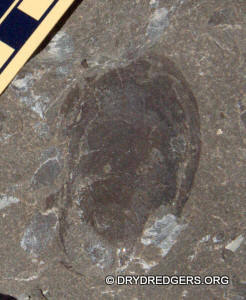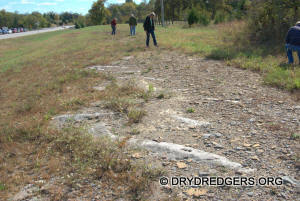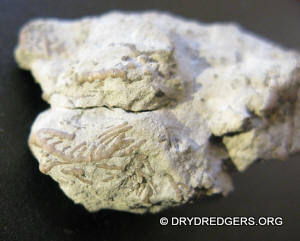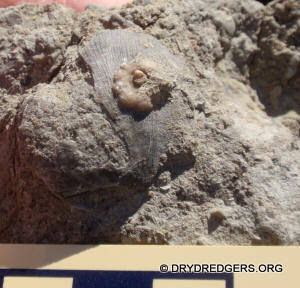




The weather on October 22 was perfect for a picnic and field trip in Central Kentucky hosted by the Kentucky Paleontological Society. The food was great, thanks to the KPS and to the people who brought side dishes. Bob Bross indicated that 15 Dry Dredgers attended along with 15 from the KPS for a total of 29 people (one person belongs to both groups).
Picnic Photos
From Bill Heimbrock
Picnic Photos From Tom Bantel
The fossils found were even better. After the picnic, Dan Phelps took us to five fossil sites. The best finds were two partial Conularia, numerous Ectenocrinus parts and best of all – a large Anomalocrinus calyx, found by Dry Dredger Mike Bahan. ”Wow!” is the standard reaction to this amazing find. Calyxes of Anomalocrinus are seldom seen. Nice job Mike! One person even found a beautiful crinoid calyx with stem attached that appears to be a Dendrocrinid of some sort.
Stop#1
Photos from Bill Heimbrock
Here is the first of two nice Conularia found. (next 2 pics)

Here is the second Conularia found on that site (next 2 pics).

Other fossils found at site #1
The 3 photos below show a negative and a positive of the cephalon of a
trilobite. The trilobite is Cryptolithus sp.



More Cryptolithus sp. trilobites were visible on the slab below.

There was a layer on this site loaded with Dalmanellid brachiopods.
Here's a clam found on site #1 with shell details preserved. It looks like it's
Caritodens sp. but I'm not sure due to
the preservation.
Some interesting Bryozoans were found. These next 4 photos show examples of two
specimens of Prasapora sp.



Stop #2
Photos from Bill Heimbrock
At site #2, the geologic feature to see were these meter-length ripple marks.



Here is what is probably a Lichenocrinus-style holdfast. Also seen on
this same rocks is the lace colar of a Cryptolithus
trilobite.

Here's a clam someone found with shell details preserved. It looks like it's
Caritodens sp.

Here is a slab with Merocrinus sp. stems all over it
along with Dalmanelid brachiopods.

Also found as a layer rich in phosphates. Shown in this closeup, you can see
some tiny steinkerns (internal molds) filled in with phosphate.
Stop #3
Photos by Bill Heimbrock
Here are some photos from Mike Bahan of the awesome Anomalocrinus
calyx found at stop #3. Wow is the standard reply. These are almost never found
and are extremely rare. Nice going Mike! (next 6 pics)






Separately, an Anomalocrinus holdfast was found. Probably not the from same
animal.
Some of the other great finds at site #3 were these crinoid
calyxes. (next 2 pics)

The gastropod Cyclonema sp. was really common on this
site. (next 4 pics)




Here's a crinoid stem that might be
Anomalocrinus sp.

This next slab has some really strange plates on the surface that look like some
kind of Echinoderm. It could be a cystoid or
rhombiferan, but the surface is so worn, it's hard to tell. (next 3
pics; last photo complements of Dom Cioffi).



Stop #4
From Bill Heimbrock
Fossils Found at Stop #4
This site was good for finding straight-shelled nautiloid cephalopods. (next 3
pics)



I think this crinoid stem is
Merocrinus sp.
On this site, there was a layer with slabs loaded with the brachiopod Sowerbyella sp. Doesn't this look great? (next 2 pics)
Stop #5
From Bill Heimbrock
Stop #5 was a really good site for fragments of the trilobite
Isotelus sp. Here's a couple of
photos of a nice cephalon fragment showing the eye of the trilobite.

This next Isotelus fragment shows the genal spine.

Several nice hypostomes (mouth plates) were found. These are also from
Isotelus. (next 2 pics)


Bryozoans Found at stop #5
Here is an example of the bryozoan Constellaria sp.

This next unidentified bryozoan has holes on it that generally referred to as
Trypanites.

This is a snail internal mold.

Take a look at this crinoid holdfast on a brachiopod. The holdfast is of the
type Lichenocrinus.

These next two photos show lots of the tiny brachiopod
Zygospira sp..


And finally, here's a straight-shelled nautiloid cephalopod found on stop #5.

That's all for this trip. Our thanks to Dan Phelps and the Kentucky Paleontological Society for hosting this excellent field trip and picnic.
Back to the Field Trip Index Page
Return to Dry Dredgers Home Page
The Dry Dredgers and individual contributors reserve the rights
to all information, images, and content presented here. Permission to reproduce
in any fashion, must be requested in writing to
admin@drydredgers.org.
www.drydredgers.org
is designed and maintained by Bill Heimbrock.